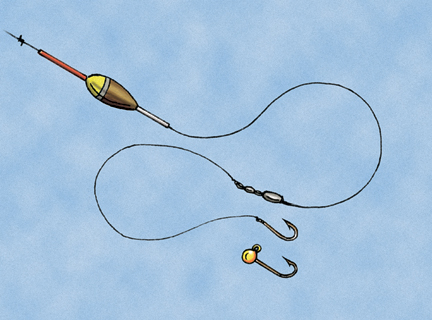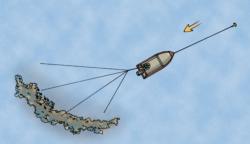Slip-bobber walleyes
Easy to rig and exciting to fish, this versatile technique produces big results

“There it goes! My bobber is down; he really popped it!” sounds the familiar cry. The excitement builds as slack line is gingerly retrieved, anticipation increasing as extended arms tightening for a hook-set. “There he is. I can feel him!” A sweeping motion quickly follows, driving the hook home. There’s a momentary pause, and the fight is on.
This oft-repeated scenario occurs wherever walleyes swim. Slip bobbers, or “floats” as aficionados like to refer to them, are effective for catching shallow, deep or suspended walleyes year-round. This versatile technique is easy to rig and exciting to fish, and often produces big results.
Throughout the walleye range the annual spawning ritual kicks off in late March in many Southern waters and extends to early June in the North. Increasing daylight and water temperatures (the mid-40s are optimal) provide the catalyst for roaming, romancing walleye schools to perform their annual ritual.
Water clarity is at a peak during and immediately following the spawn, diminishing as the water warms and the food chain emerges. Positioning of the walleyes’ preferred forage becomes a determining factor as to where this species will locate as the season unfolds.
This clearwater period can bring out a walleye’s finicky side by allowing fish greater visibility and increasing their strike zone. A finesse presentation, made from a slip-bobber setup, tantalizingly dangling in front of a wary walleye’s nose, often proves an irresistible offering.
Most “fish historians” concede that this technique originated on Minnesota’s Mille Lacs (a large, natural walleye lake), in the early 1970s. Adopting panfishing techniques, anglers were able to fish “snaggy” rock reefs without losing a ton of tackle and also target suspended fish in deep-water locations.
The presentation
Let’s get you rigged up. Spinning gear is usually preferred with this tactic. Try a 6-foot-6-inch to 7-foot rod with a medium-light action. The longer rod will increase your casting distance with this light-tackle presentation. Mono line in 4- to 8-pound-test on an ultra-light to medium-size reel works best.
There are several bobber stops to choose from; I recommend the type made from pre-tied nylon (you can find them in your Wal-Mart fishing department). Place one on your line, cinch it down and clip off the loose ends. Next install the float and the weight. Use a bullet or egg sinker in 1/8- to 1/4-ounce size and tie the line to a small swivel.
Now you’re ready for the business end of this presentation. Attach a 2-foot leader made from lighter line than that which is on your reel. For example, if you’re spooled with 8-pound line, tie on a 6-pound-test leader. A fluorocarbon line, like Berkley Vanish, works well in this application. If you catch up on the bottom, the lighter leader will break off. This saves you time re-tying.
Next comes the hook, and there are several options to consider. In calm conditions, try a plain hook in a size six or eight. I prefer a premium hook (this will increase the hooking percentage significantly), and colored hooks often provide an additional flash to attract walleyes to your presentation.
Small lead-head jigs are also a good bet, especially in windy conditions. Bright colors in 1/16- and 1/32-ounce sizes will add just enough weight to get your bait to the strike zone.
The bait debate
A lively leech is definitely the best live-bait option, once water temperatures exceed 50 degrees (leeches tend to roll in a ball and go dormant in cold water). Hook the leech once through the “sucker end” for best results. Leeches come in a variety of sizes, and this can be a key factor in triggering fish. I’ve always found the largest or jumbo-size leeches to be most effective in the springtime postspawn period, and I usually downsize as the season progresses.
Minnows, hooked thru the dorsal fin, can be effective when water temperatures are below 50 degrees. Once temperatures exceed 60 degrees, night crawlers tend to produce well.
When your bobber goes down, point the rod toward the last location and begin to reel slowly to remove the slack line. Lift the rod tip gently to feel the fish, and upon initial contact, use a sweeping motion to set the hook.
Location, location, location!
If you want to do a brisk walleye business, here are some keys to pay attention to.
Most slip-bobber approaches are best made from an anchored position. A 27-pound “navy-style” anchor with 100 to 150 feet of rope is a must. This allows you to hold in the roughest conditions and occasionally adjust your position with the extra rope.
Locations adjacent to spawning areas are usually the first spots to load up with walleyes on a postspawn feeding binge.
Always position your boat so the target area is a short cast behind you. This allows you to cast downwind and float the bait into the prime spot, and it is especially effective in windy conditions. It allows you a higher-percentage hook set because the “bow in the line” is eliminated as the bobber drifts downwind.
 Wind-swept reefs and points always seem to attract feeding walleyes. Position your boat 10 to 20 feet upwind from the crest of the reef. This upwind edge is the key area that usually holds the aggressive fish. Once positioned, fan-cast until you locate a pocket of active walleyes or until you clear the area. When the action slows on the front edge, you can let additional rope out to reach the fish positioned on the back of the reef.
Wind-swept reefs and points always seem to attract feeding walleyes. Position your boat 10 to 20 feet upwind from the crest of the reef. This upwind edge is the key area that usually holds the aggressive fish. Once positioned, fan-cast until you locate a pocket of active walleyes or until you clear the area. When the action slows on the front edge, you can let additional rope out to reach the fish positioned on the back of the reef.
Moving frequently increases your odds with this presentation. When the action slows, pull the anchor and reposition on a new spot.
Now you have the basics of one of the most effective walleye techniques ever discovered. Once you’ve tried this presentation, you’ll soon discover how easy and fun it is to fish a slip-bobber setup. It catches walleyes, and lots of them.
So slip on that float, and you’ll be reeling in walleyes in no time at all.